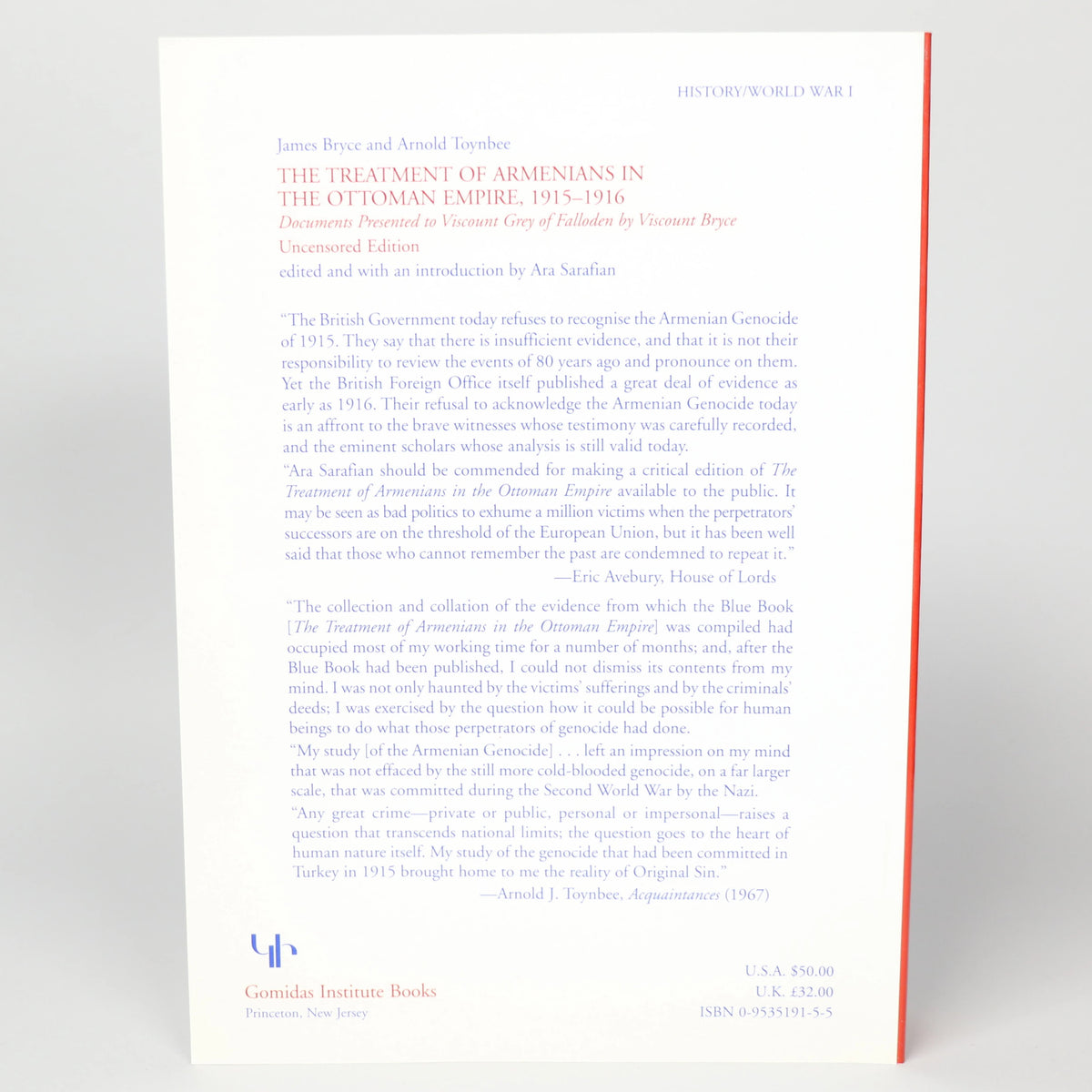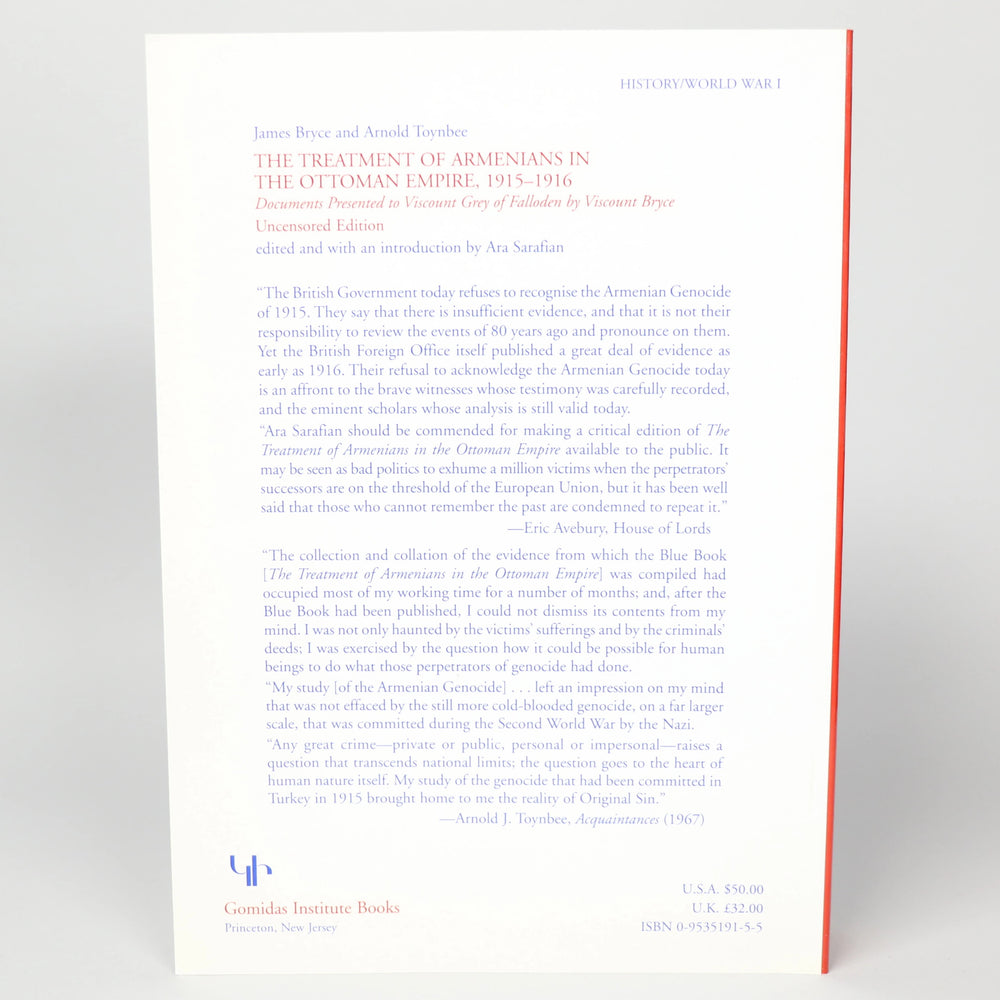By James Bryce and Arnold Joseph Toynbee
In 1916 the British Parliament published a "Blue Book" that identified the events of 191516 as a systematic effort to exterminate the Armenian people. The Blue Book has been one of the most solid and influential sources on the Armenian Genocide. A critical, uncensored edition, edited and with an introduction by Ara Sarafian, has been published by the Gomidas Institute. Viscount James Bryce and Arnold Toynbee were commissioned to prepare the Blue Book, which is formally known as The Treatment of Armenians in the Ottoman Empire, 19151916. Toynbee carefully compiled and verified dozens of eyewitness accounts from different parts of the Ottoman Empire. These accounts provided the basis for Bryce's brilliant thesis on the Genocide, published while the crime was still in progress. The book includes eyewitness accounts from United States consular and missionary sources, as well as the testimony of German, Italian, Danish, Swedish, Norwegian, Greek, Kurdish, and Armenian witnesses.
Sarafian shows exactly how testimonies were collected, authenticated, and then used in the book. Generations of official historians of Turkey, such as Enver Zia Karal (Ankara University), Salahi Sonyel (British historian and public activist), Ismail Binark (Director of Ottoman archives, Ankara), Sinasi Orel (director of a much publicized project on declassifying documents on Ottoman Armenians), Kamuran Gurun (former diplomat), Mim Kemal Oke, Justin McCarthy, and others have cited the Blue Book and have insisted that it lacks credibility. Sarafian has located Toynbee's original manuscript, Toynbee's correspondence with his sources, and most of the original reports, which were copied and sent to London. They can still be found at the Public Record Office (Kew), Bodleian Library (Oxford), National Archives (Washington, D.C.), Library of Congress (Washington, D.C.), and the Houghton Library (Cambridge, Mass.) He has established that the compilers were meticulous in their verification of sources.According to the Times Literary Supplement (London), "This work emerges from Ara Sarafian's examination as documentation of a high order. . . . Sarafian convincingly rebuts the claims that there was any falsification, or that any of the documents was one-sided British propaganda." Lord Avebury of the British House of Lords has welcomed the publication of this critical edition of the Blue Book. Excoriating the present-day British government for refusing to recognize the Armenian Genocide, "ostensibly for a lack of evidence," Lord Avebury notes that "the British Foreign Office itself published such evidence as early as 1916. . . . Ara Sarafian should be commended for making a critical edition of The Treatment of Armenians in the Ottoman Empire available to the public."
- Gallery
- Description


By James Bryce and Arnold Joseph Toynbee
In 1916 the British Parliament published a "Blue Book" that identified the events of 191516 as a systematic effort to exterminate the Armenian people. The Blue Book has been one of the most solid and influential sources on the Armenian Genocide. A critical, uncensored edition, edited and with an introduction by Ara Sarafian, has been published by the Gomidas Institute. Viscount James Bryce and Arnold Toynbee were commissioned to prepare the Blue Book, which is formally known as The Treatment of Armenians in the Ottoman Empire, 19151916. Toynbee carefully compiled and verified dozens of eyewitness accounts from different parts of the Ottoman Empire. These accounts provided the basis for Bryce's brilliant thesis on the Genocide, published while the crime was still in progress. The book includes eyewitness accounts from United States consular and missionary sources, as well as the testimony of German, Italian, Danish, Swedish, Norwegian, Greek, Kurdish, and Armenian witnesses.
Sarafian shows exactly how testimonies were collected, authenticated, and then used in the book. Generations of official historians of Turkey, such as Enver Zia Karal (Ankara University), Salahi Sonyel (British historian and public activist), Ismail Binark (Director of Ottoman archives, Ankara), Sinasi Orel (director of a much publicized project on declassifying documents on Ottoman Armenians), Kamuran Gurun (former diplomat), Mim Kemal Oke, Justin McCarthy, and others have cited the Blue Book and have insisted that it lacks credibility. Sarafian has located Toynbee's original manuscript, Toynbee's correspondence with his sources, and most of the original reports, which were copied and sent to London. They can still be found at the Public Record Office (Kew), Bodleian Library (Oxford), National Archives (Washington, D.C.), Library of Congress (Washington, D.C.), and the Houghton Library (Cambridge, Mass.) He has established that the compilers were meticulous in their verification of sources.According to the Times Literary Supplement (London), "This work emerges from Ara Sarafian's examination as documentation of a high order. . . . Sarafian convincingly rebuts the claims that there was any falsification, or that any of the documents was one-sided British propaganda." Lord Avebury of the British House of Lords has welcomed the publication of this critical edition of the Blue Book. Excoriating the present-day British government for refusing to recognize the Armenian Genocide, "ostensibly for a lack of evidence," Lord Avebury notes that "the British Foreign Office itself published such evidence as early as 1916. . . . Ara Sarafian should be commended for making a critical edition of The Treatment of Armenians in the Ottoman Empire available to the public."

